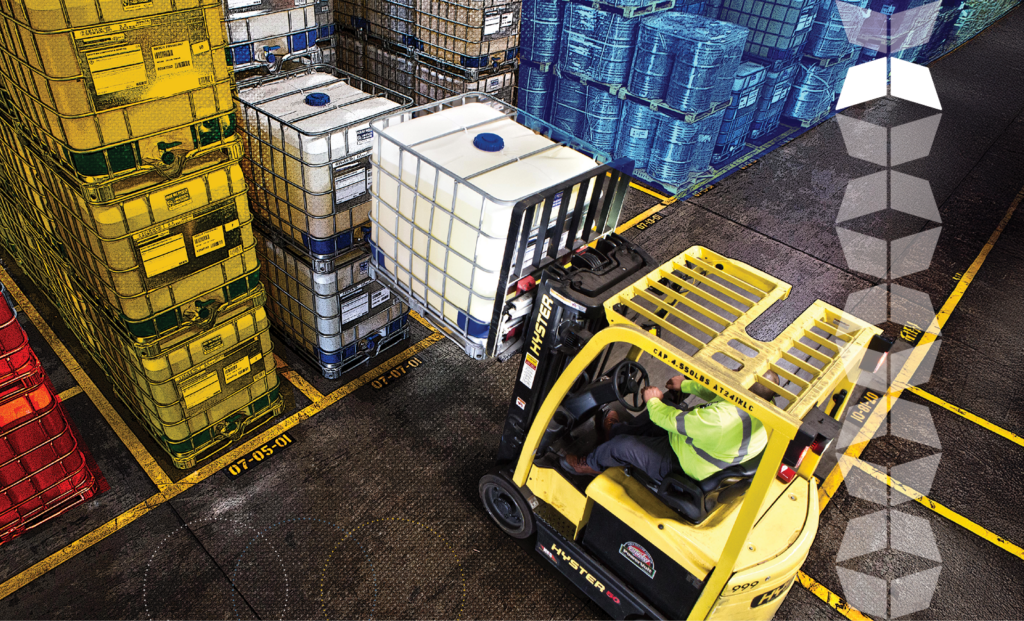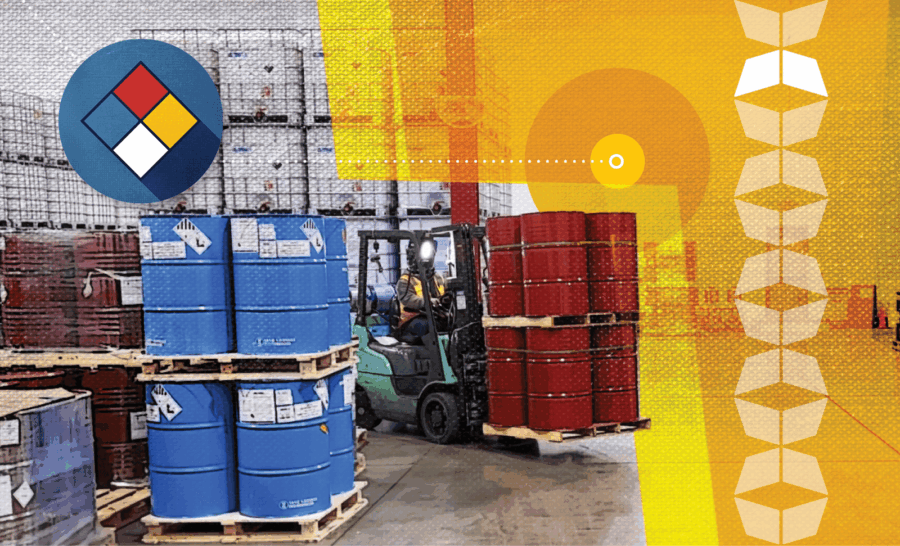Quarterly Chemical Logistics Pulse
Volume 1, Issue 1
Welcome to WSI’s Quarterly Chemical Logistics Pulse. The information assembled here, which covers market dynamics, supply chain resilience, the regulatory environment, and investment trends, can help you make timely, informed decisions and intelligently navigate the current chemical logistics sector.

Market Dynamics Shaping Chemical Logistics in 2025
Topping the list of challenges and opportunities shaping the chemical logistics market are concerns around potential tariffs, geopolitical tensions, and unpredictable weather events. Fluctuating trade and tariff policies are driving uncertainty and constraining economic activity both within the U.S. and across the globe. A lack of clarity makes it difficult for business leaders to make informed decisions, so firms are delaying orders. The volume of chemical exports dropped by 2.9 percent in May, the American Chemistry Council (ACC) reported in its Mid-Year Situation & Outlook 2025. As of mid-July, sales of agricultural and specialty chemicals were down by 8.8 and 8.1 percent, respectively. Over the past year, exports dipped by 2.2 percent while imports shrunk by 7.8 percent. The chemical trade surplus shrank from $2.5 billion in April to $1.9 billion in May, also according to the ACC.
Companies also are postponing investments and hiring as they wait to see the potential impact of trade policies, the ACC reported. This is one factor lowering GDP growth. The ACC lowered its estimates of U.S. GDP growth from 2.7 to 1.3 percent in 2025, and from 2.0 to 1.6 percent in 2026.
While it’s difficult to pinpoint exactly how the proposed tariffs will impact costs, early industry estimates suggest increases of 8 to 15 percent on selected intermediate and specialty chemicals, according to Hilco Global, a financial services firm. Longer lead times and inventory build-ups are also anticipated, as companies reroute sourcing and front-load shipments, either in anticipation of or in response to tariffs. WSI has already seen some inventory build-up, particularly among chemical manufacturers, building materials companies, and other industrial clients where supply chain interruptions can halt production lines and jeopardize critical customer commitments.
If tariffs disrupt trade between the United States and Canada, the results could be significant, given the volume of chemical transactions between the two countries. The U.S. imports more than $32 billion worth of chemicals from Canada, while Canada relies on the U.S. for 77% of its chemical exports, according to ChemCeed, a chemical supplier.
In July, President Trump announced tariffs of 35 percent on Canadian goods shipped into the U.S., to go into effect August 1, 2025. For their part, Canadian companies appear focused on developing other markets. In a March statement on the proposed tariffs, the Chemical Industry Association of Canada said, “Expanding into new markets beyond North America—both east and west—is vital for economic growth and long-term prosperity.”.
To be sure, concerns about tariffs are shared by many business leaders outside the chemical logistics sector. More than half of U.S. companies reported declines in their gross margins as a direct result of tariffs, with one-quarter experiencing drops of more than six to ten percent, according to the July KPMG Tariff Pulse Survey. International sales are reeling, with nearly one-third of respondents experiencing drops of between 16 and 25 percent in overall foreign sales.

Chemical Supply Chain Resilience Check-Up: Mid 2025
Given that more than 40 percent of base chemicals are traded globally, according to estimates from OPIS/Dow Jones’ Chemical Market Analytics, geopolitical events inevitably impact supply chains. Russia has been the single largest supplier of oil and gas to Europe, so the war with Ukraine has led to significant shifts in both energy and chemicals flows across the globe, OPIS notes. Europe has begun importing more refining products, oil, and gas from the U.S. and the Middle East, while Russia is shipping more to India, China, and Brazil. With the EU increasingly reliant on imports, more vessels are coming into EU ports. However, a lack of exports to fill vessels on their return routes is leading to a mismatch in trade volumes coming into and out of region, prompting higher inbound shipping costs, OPIS said.
In a separate conflict, Houthi rebels have been attacking ships navigating the Bab el-Mandeb Strait. Along with the Suez Canal, the Strait forms a portion of the shipping route between Europe and Asia. To avoid the attacks, many ships are taking a longer route around the Cape of Good Hope, OPIS says.
On the other side of the globe, the Panama Canal, by connecting the Atlantic and Pacific Oceans, has also been key to global trade. However, declining water levels cut transit through the Canal by more than one-third, leading to significant trade disruptions, according to UN News. Among the spillover effects, exports of American soybeans dropped, and grocery stores in the UK reported shortages and rising prices.
Given the massive volume of chemicals traded across borders, robust supply chains will be critical as companies navigate the changes and challenges pummeling the global chemical sector. More than half of businesses across multiple industries are working to reconfigure their supply chains, KPMG found. However, almost half need seven to 12 months to implement significant supply chain adjustments, including potentially reshoring manufacturing to the U.S. Barriers to action include higher labor costs and the capital required to make significant changes
Another supply chain concern is the average age of the global shipping fleet, which hit 13.7 years in December 2023, the highest since 2009. A primary constraint on new ship orders is the lack of regulatory clarity, OPIS notes.
While vessel age shouldn’t be an issue so long as the ships are properly maintained, most older vessels need to run more slowly to comply with lower emission standards. The aging fleet also highlights the lack of investment in shipbuilding. This could lead to a vessel supply shortage, given growing demand for chemicals.
To address these challenges, companies are looking to deploy technology within their supply chain and logistics operations. Artificial intelligence, in particular, is capturing attention. By 2030, half of supply chain management solutions will include agentic AI solutions, Gartner predicts. (These solutions provide a virtual workforce of AI agents that can assist and human work or traditional applications, Gartner says). For instance, a procurement agent would be able to autonomously purchase supplies, taking into account inventory stock levels, projected demand, and market conditions.
Another key is optimizing chemical distribution networks. BCG has found that optimizing outbound distribution chains can reduce costs by as much as 20 percent while maintaining or even improving service levels. Moreover, optimized and cost-efficient supply chains tend to be more sustainable and resilient.
Several steps can help supply chain organizations achieve these benefits, BCG says. A starting point is integrating data from multiple sources to create transparency and build a single source of truth that can be used to analyze the network and material flows. Next is planning the network’s future state and then identifying a path for making improvements, including quick wins, mid-term improvements, and longer-term targets. After this, it’s time to make sustainable changes while also monitoring their impact.
The New Chemical Logistics Regulatory Reality
Manufacturers continue to report an increasing level of regulatory burden, such as compliance and opportunity costs, the ACC reports. For example, of 431 new chemicals under review for the Toxic Substances Control Act (TSCA), just 40 have been reviewed within the TSCA-mandated period of 90 days, the ACC says. The backlog is impeding investments in the production of new and innovative chemicals, according to the ACC.
Multiple industry organizations and their members are bringing their regulatory concerns to policy makers. In June, Brett Mears, president of Palmer Logistics and a member of the Alliance for Chemical Distribution (ACD), testified before the Occupational Safety and Health Administration (OSHA) about the proposed rulemaking on heat injury and illness prevention in outdoor and indoor work settings. “As written, the proposal threatens to bury employers in red tape while doing little to protect the workers it aims to help,” Mears said.
Not all is bleak on the regulatory front, however. The Society of Chemical Manufacturers and Affiliates (SOCMA) welcomed the inclusion of expanded research and development tax credits in the One Big Beautiful Bill Act, stating that it will help America remain on the cutting edge of technological advancement.
And in February letters to the EPA, DOL, and DHS, the ACD highlighted several regulations, including the Toxic Substances Control Act and the Hazard Communication Standard, that meet the criteria for reconsideration under an executive order on deregulation. “While worker safety and economic well-being are paramount, these proposals do little to benefit workers and place immense burdens on employers,” Eric R. Byer, ACD president and chief executive officer, said in his letter to the DOL.
Infrastructure Investment Trends
Even amidst the broader economic uncertainty, some chemical companies are investing and expanding. This appears particularly true for recycling and sustainability efforts. Examples include:
In November 2024, ExxonMobil announced plans to invest more than $200 million to expand chemical recycling operations at its sites in Baytown and Beaumont, Texas.
In May of 2025, Pittsburgh International Airport and Avina Synthetic Aviation Fuel said they were partnering to develop the first on-airport sustainable aviation fuel (SAF) production facility utilizing one of the very first alcohol-to-jet pathways in the U.S.
In June 2025, Stardust Power Inc., an American developer of battery-grade lithium products, announced a Memorandum of Understanding with Ohio University for a strategic partnership focused on advanced lithium extraction and refining technologies. The initiative could potentially lead to deeper research into domestic lithium processing innovations, the statement said.
About WSI: Certified Chemical Logistics Services
WSI is a trusted partner for chemical logistics, providing secure, compliant, and efficient solutions for hazardous and specialty materials. Industry leaders in petrochemicals, plastics, and industrial chemicals rely on WSI for warehousing and distribution across the United States.
Our certified facilities meet stringent DOT, EPA, OSHA, and DHS standards, and our team holds specialized certifications including IMDG, IATA, DOT, and HAZWOPER. We offer temperature-controlled storage, custom packaging and labeling, expert handling, and value-added services like blending, dilution, and fulfillment.
As the first 3PL certified as a Responsible Care® Partner, WSI is committed to health, safety, and sustainability. With advanced technology, nationwide infrastructure, and decades of experience, we help chemical companies protect their products, their people, and their reputation.
Talk with a WSI expert to explore customized chemical logistics services that prioritize safety, compliance, and performance.




